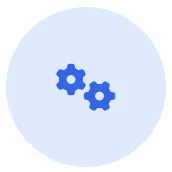Smarter Workflows and Digital Marketing, Powered by AI Automation

We help professional services, manufacturing, heavy equipment, and technical firms across Canada and the United States automate quotes, invoices, client communication, and digital marketing campaigns so your business runs faster and leaner.

Trusted by Growing Businesses














Are These Challenges Slowing You Down?
Missed Quotes & Calls Mean Lost Customers
Businesses lose up to 27 percent of leads because they cannot respond quickly to new inquiries.
Social Media That Consumes Your Time
Spending hours posting online takes you away from customers, yet you need visibility to compete.
Manual Review Requests That Do Not Convert
Competitors with automated review systems outrank you while you chase reviews one by one.
Disjointed Systems Working Against You
Juggling 5+ different apps that don't
work together, creating more work
instead of simplifying it.
Inconsistent Follow-ups
Losing potential sales because manual follow-up processes fall through the cracks when you're busy.
Learning Curve Anxiety
Knowing you need better technology but having no time to research, learn, and implement new systems.
We Power Your Business with Smart Automation
From workflow automation to customer engagement, we design and manage systems that keep your operations running without manual effort.
Built for professional services, heavy equipment, manufacturing, and technical service companies
Partnership Approach
We're invested in your success, not just selling software
Operational Focus
Focused on saving time, reducing costs, and improving efficiency
Local Advantage
Canadian-based team serving North America
Our Simple 3-Phase Partnership Process
Simple, Fast, Results-Focused

🎯 Phase 1: Discovery & Strategy
Understanding your business,
identifying challenges, and
creating a custom growth strategy
tailored to your specific needs.
Your involvement:
One consultation call + simple questionnaire

🚀 Phase 2: Setup & Implementation
Complete system setup while you
serve customers. Zero disruption to
your business operations.
Your involvement:
Minimal - we handle the heavy lifting

📈 Phase 3: Growth & Optimization
Ongoing partnership with system monitoring, optimization, and strategic guidance as you grow.
Your involvement:
Monthly check-ins and growth planning
Focus: Get you operational quickly so you can focus on what you do best - growing your business
Why Professional and Technical Firms Partner with ScaleOps AI
The partnership difference that's transforming small businesses across Canada
We're Different Because We're Partners, Not
Vendors
❌ Traditional Software Companies Say:
"Here's the software, here's the manual, training videos, good luck!"
✅ ScaleOps-AI Partners Say:
We'll handle the setup, train your team, monitor performance, and optimize everything as you grow. Your success is our success
10-15+
Hours saved weekly for most clients
40-60%
Boost in operational efficiency
3-5x
Faster customer response times
$2-4k
Monthly cost savings from automation
What Makes Our Partnership Different

🤝 True Partnership Approach
We act as an extension of your team, not a software vendor.

🎯 Industry Specialists
Tailored for professional services, manufacturing, heavy equipment and technical firms.

⚡ Simple Process, Fast Results
Clear three-phase system with minimal time commitment from you.

🇨🇦 Local Advantage
A Canadian-based team serving clients across Canada and the United States.
Choose Your Growth Partnership Level
📦 Automation Essentials
For companies that need core processes automated and monitored.
Set up and ongoing management of up to three core automations
Examples: CRM setup and lead routing, quote follow up, invoice reminders
Ongoing monitoring to ensure reliability
Monthly reporting and check-in
MOST POPULAR
📈 Growth Partnership
For companies that want automation plus customer engagement systems, competitors already use.
Everything in Automation Essentials
Automated Google review management
Business listings setup and management
Website chatbot with lead capture and FAQs
Missed call text back automation
Chatbot integration across Facebook, Instagram, and WhatsApp to automate lead capture and responses
🚀 Strategic Partnership
For established companies that want automation, customer engagement, and marketing leadership.
Everything in Growth Partnership
Annual website refresh and optimization
Ongoing SEO management
Two professional blog posts per month
One lead magnet landing page per quarter
Three automated campaigns per quarter
Examples: lead nurturing, special promotions, customer newsletters
Monthly reporting and strategy review
Additional Services Available
We also offer specialized add-on services, including SEO, Google Ads Management, Meta Ads Management, LinkedIn Ads, Email Marketing, and Brand & Design Services.
Contact us to discuss pricing and availability for these additional partnership services.
What Our Partners Say
Get in touch with your trusted technology partners
Olena - Founder, Harmony Home Organizing

“After a disappointing experience with a previous service provider, I was skeptical about starting over with another firm. But ScaleOps completely turned things around. They quickly assessed the situation, picked up where things had stalled, and delivered results that went above and beyond right on schedule. Their professionalism, responsiveness, and ability to work under tight deadlines gave me confidence every step of the way. I wouldn’t hesitate to recommend ScaleOps to any business in need of reliable support.”
Bill – Founder, BK Cabinets

“I initially hesitated to take on this project due to tight time and resource constraints. Choosing ScaleOps turned out to be a game-changer. They took the time to understand our needs, proposed a practical and time-efficient solution, and executed everything flawlessly. The project was completed on time, within budget, and exceeded our expectations. Lisa and her team made the process seamless, and I’d confidently recommend them to anyone aiming to streamline and strengthen their operations.”
Shaoli – Founder, SoftwarePros

“Our partnership with ScaleOps has been a turning point for our business. In just six months, we’ve gained four new clients largely thanks to their strategic insight and execution. Their collaborative style, industry know-how, and ability to align with our internal processes have made them an indispensable partner. We truly value the relationship and are excited to continue building on this momentum together.”
Lakhi – Operations Manager, BN Dulay Trux Ltd.

“Partnering with ScaleOps-AI has been a major relief for our internal team. From automating our customer review process and managing social media, to assisting us with everyday tech and workflow questions they’ve removed a lot of the operational burden. Their consistent support has allowed us to stay focused on our core business without getting bogged down by tech or admin tasks.”
Marcus – Owner, GreenScape Landscaping

"We're great at landscaping, terrible at paperwork. We'd finish amazing projects but never follow up on quotes or ask for reviews; just too busy. ScaleOps built us a system that does all that automatically. Our quote responses went up 40% and we actually have real reviews now instead of crickets. Finally feels like we're running a real business, not just winging it
Maggie – Founder, Bloom Creative Studio

"Honestly, I was drowning when I started my business. Between trying to build a website, chase invoices, and book clients, I barely had time to do the actual work I loved. ScaleOps set up everything: my website, booking system, automated invoicing, the works. Now I just focus on my clients while everything else runs itself. Best decision I made as a new business owner. "
Trusted by Growing Businesses














Ready to Partner with Us for Your Business Growth?
Get in touch with your trusted technology partners
Contact Information

Phone


Business Hours (PST)
Mon-Fri: 8:00 AM - 6:00 PM
Saturday: 9:00 AM - 2:00 PM

Location
Serving businesses across Canada and USA
